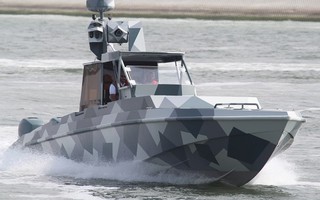
Which can also be enabled for shooting any light target in the air. there are 2 Vector canon unit G 12 caliber 20 mm made in sweden. this is the latest Exocet missile variant made in France. there are 4 Exocet Missile Block 3 for destoy any surface target. main weapon is a cannon OTO Melara Super Rapid Caliber 70 mm. This ship is armed with anti surface warship. The heavy gunfire can be used to cause severe setback to enemy positions and assets but without larger damage like that of a missile attack, which would hamper operations of own soldiers.Let's see. The naval gunfire is also deployed for support or breaching operations as they can be used while landing or amphibious operations on the shore. The guns also come in handy for area domination operations, or taking out a fast patrol vessel advancing towards the warship. This includes taking on the vessels in the sea or targets on shore as well as incoming enemy aircraft or even drones. Given that these guns can be deployed for both anti-surface and anti-air operations, they provide a lot of flexibility to the warship at sea. Moreover, there are multiple operations and tasks that only a naval gun can carry out. Using a naval gun is cheaper than firing a missile. Except for the 30 mm Close-In Weapon System (CIWS), all these guns form part of naval artillery. The Navy had then selected the MK 45, which are manufactured by BAE Systems Land and Armaments.Įvery naval vessel in the world, including the aircraft carriers, has different types of integrated guns. However, in 2015, then defence minister Manohar Parrikar decided against dealing with Finmeccanica, the key gun supplier to the Navy. In 2013, OTO Melara emerged as the sole bidder in the naval gun tender. But this plan ran into rough weather as the company is owned by Finmeccanica, which is embroiled in the VVIP chopper scam in India. The Navy’s original plan was to procure the 127 mm guns from the Italian firm OTO Melara. The long range is basically due to new 5-inch Cargo projectile and an improved propelling charge.Īlso read: No consensus yet on structure of theatre commands, discussions, tweaks to continue
#Warship craft oto melara mod
The 127-mm 62-calibre MK-45 Mod 4 Naval Guns have a Naval Surface Fire Support range of more than 20 nautical miles (36 km). The remaining two guns are destined for the INS Dronacharya missile and gunnery school, and INS Valsura electrical and weapons engineering school. Part of the Naval artillery, the guns are to be fitted on the four new Project 15B Visakhapatnam-class stealth destroyers and the seven Project 17A stealth frigates. Logistics and maintenance will have to cater for these 11 ships exclusively,” the source said. “Only 11 ships would have had this particular gun system. As and when that materialises, the 76 mm guns will be replaced,” said a source.Īnother reason was the logistics involved. The Navy will use the existing 76 mm guns while a larger plan for the 127 mm guns bears fruit. More than the gun itself, the specialised ammunition is more expensive.

The cost factor was the primary reason behind junking the deal that was to be made under the Foreign Military Sales (FMS) route, sources said, adding that the 127 mm guns - 13 in number - would have cost India about $1 billion. Sources in the defence establishment said the Navy is looking at a larger Make in India initiative for the 127 millimetre (mm) gun systems rather than opting for the deal with the US, which was cleared by the Donald Trump administration in 2019. New Delhi: The Indian Navy is set to junk the proposed acquisition of 13 MK-45 anti-surface and anti-air gun systems from the US for its 11 under-construction frigates and destroyers, ThePrint has learnt.


 0 kommentar(er)
0 kommentar(er)
